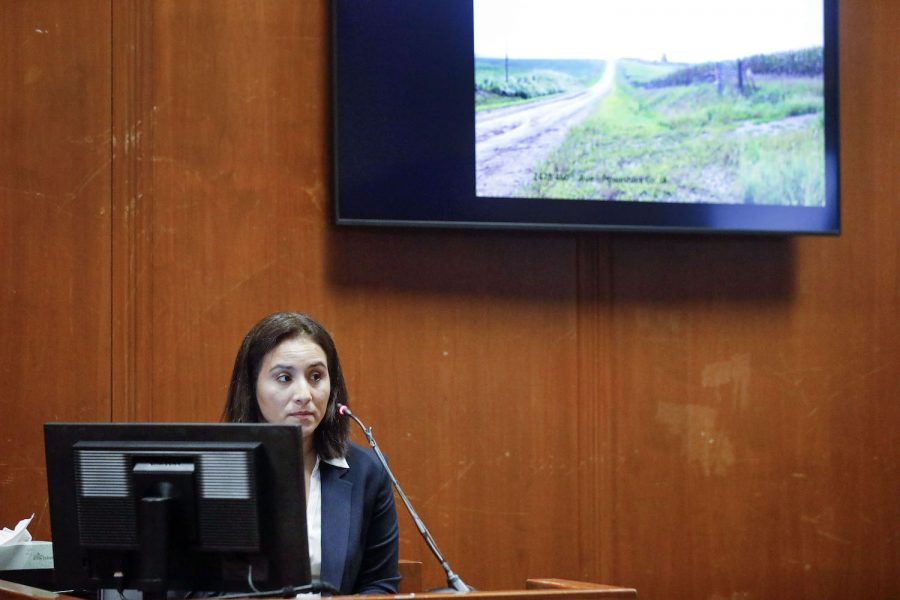Rivera trial: former Iowa City police officer among witnesses, translates interview, admission from defendant
Federal, state, and local authorities, including former Iowa City police officer Pamela Romero, testified on the fourth day of the trial of Cristhian Bahena Rivera, who is accused of first-degree murder.
Former Iowa City police officer Pamela Romero testifies as an image of near where the body of Mollie Tibbetts was found is shown on a monitor during the trial of Cristhian Bahena Rivera at the Scott County Courthouse in Davenport, Iowa, on Thursday, May 20, 2021. Bahena Rivera is charged with first-degree murder in the death of Tibbetts. (Jim Slosiarek/The Gazette)
May 20, 2021
Witness testimonies continue in the trial of Cristhian Bahena Rivera, accused of first-degree murder in connection to the death of Mollie Tibbetts. State and local law enforcement officials testified on their process of solidifying the timeline in Tibbetts’ disappearance.
The trial entered its fourth day on Thursday, after two days of jury selection and one day of witness testimony and opening statements. The prosecution delivered its opening statement on Wednesday, asking the jury to find Bahena Rivera guilty.
Six witnesses took the stand on Thursday to testify, bringing the total number of witnesses that have testified so far to 12. Among those were Poweshiek County investigator Steve Kivi, Iowa Division of Criminal Investigation Agent Derek Riessen, and former Iowa City police officer Pamela Romero.
Editor’s Note: The order of witness testimonies has been changed to highlight the translation of Cristhian Bahena Rivera’s interview and admission in a law enforcement vehicle. Pamela Romero was not the first witness to testify on Thursday.
Pamela Romero
Pamela Romero, a former Iowa City and West Liberty police officer, said she was requested to assist with interviewing Spanish-speaking individuals in the case of Tibbetts’ disappearance.
Romero is a native Spanish speaker and immigrated to the U.S. when she was 10 years old. She learned English after being enrolled in 5th grade in West Liberty, Iowa.
On August 20, 2018, she arrived in Montezuma, Iowa – a city in Poweshiek County – and was told she was to assist with interviewing Bahena Rivera. She said at the time, she was briefed by the Iowa Division of Criminal Investigation and FBI agents at the Poweshiek County Sheriff’s Office about the case prior to the interview. The body of Tibbetts had not yet been discovered.
She said she introduced herself to Bahena Rivera, who was waiting in the lobby, and thanked him for waiting patiently. She did not think he saw her badge that identified herself as a police officer.
She said Bahena Rivera was cooperative during the interview, and showed him the unlocked door so he knew that he was able to leave the room at any time.
Romero said she spoke Spanish during the recorded audio and video interview, which included Romero, Bahena Rivera, and Iowa City Sergeant Jeff Fink. She said the interview lasted over 11 hours, and he was friendly and very engaged.
She asked him about his employment, family history, the vehicles he had, and who he lived with to build rapport. Romero said Bahena Rivera told her he owned a black Chevy Malibu that he had purchased from his cousin in Tama, and also mentioned a Nissan Altima that he said he drove in gravel back roads that was not up to date with registration.
Bahena Rivera told Romero he had been in the U.S. for seven years and in Brooklyn, Iowa, for four years, she testified. He told her he started working at Yarrabee Farms milking cows, and then moved to cleaning sections of the farm, Romero said.
Romero said herself and the defendant took frequent breaks, but she was with Bahena Rivera during the entirety of the interview. She said he appeared tired toward the end of the interview.
She said she asked Bahena Rivera whether or not he knew who Tibbetts was an hour or two into the interview.
“Mr. Rivera told me he had no idea who she was and that he had never seen her,” she said. “I pulled out one of the posters that had Mollie’s face… and he looked at her, and said, ‘I have seen them around town’ and he remembered seeing Mollie’s boyfriend at one of the local gas stations.”
She added that Bahena Rivera told her he had a copy of the missing person’s poster in his car.
Romero received three pictures of the black Chevy Malibu from Collins’ surveillance video with the time stamp of July 18, 2018 at 7:48 p.m. and laid the pictures in front of Bahena Rivera, she said.
She testified that he voluntarily said the vehicle was his car without a question from Romero. She asked him if he was driving the car at that time and he said yes, and when asked if anyone else was in the car, he said no and that he was driving alone.
During the interview with Romero, Bahena Rivera called the runner “she,” despite the difficulty in seeing the gender of the person running in the video. He said he saw her three times, and she waved at him as he drove by.
He said he was heading to his uncle’s residence to get a vacuum cleaner and was driving to find his way around town. He lost sight of her after the third time and continued on his way, Romero said.
RELATED: Third day of Rivera trial begins with opening statement, witness testimonies
Bahena Rivera said during the interview he had not harmed Tibbetts nor left the vehicle to make contact with her. The conversation continued in the morning on August 21, 2018, when Kivi, Romero, Fink, and Bahena Rivera left the office to go to Bahena Rivera’s residence and Yarrabee Farms. Romero said they parked near a cornfield in southeast Brooklyn, Iowa.
Romero said Bahena Rivera wanted to speak to her and waved his Miranda rights to do so. Both Romero and Fink were in the car during the conversation, which Romero said lasted around an hour.
Romero testified that, while in the car together, Bahena Rivera admitted to her that he saw Tibbetts running on 385th Avenue and followed her in his car. He said he parked his car and jogged toward her. She noticed him and made the attempt to use her cell phone to call the police, Bahena Rivera told Romero.
He said they started fighting, and that Tibbetts tried to slap him and was screaming at him. He became angry and scared at that point, Bahena Rivera told Romero.
He remembered them fighting and he told Romero that when he becomes angry, he usually blacks out. The next thing Bahena Rivera remembered was driving and looking down to see earbuds sitting on his legs, and remembered he had Tibbetts in the back of his trunk.
The defendant stated he did not remember putting Tibbetts in the car, Romero said, but remembered taking her out of the vehicle. Bahena Rivera told Romero that he had brought Tibbetts to the cornfield they were parked at.
He remembers there was blood, and he put her on his shoulders, laid her in the cornfield, covered her with corn leaves, and left.
“At one point I asked him, ‘Was it the head, was it the forehead?’ and with a hand motion he showed the neck,” Romero said. “I asked him how her body felt against his body when he was carrying her, and he said it felt like a person who had just fainted.”
She said Bahena Rivera’s recollection of the incident was not complete. He could not remember the weapon used, Romero testified, and he had no shirt on when he was carrying her into the cornfield because it was stained with blood.
Romero said she pressed him for more details because of the gaps in information.
“I went to ask him, Mr. Rivera, ‘Please, just let me know, give me more details: How she got into the car, what happened to her, what did you do to her,’” she said. “His answer was, ‘I brought you here, didn’t’ I? So that means that I did it? I don’t remember how I did it.’”
She clarified that he answered her in the forms of questions.
She testified that when she asked him his thoughts when he saw missing person’s posters and heard people talking about the disappearance, Bahena Rivera shrugged his shoulders and said “I didn’t think about it.”
During cross-examination, Jennifer Frese, second defense attorney for Bahena Rivera, informed Romero that Bahena Rivera’s indication of an injury on Tibbetts’ neck is not consistent with the injuries found on Tibbetts’ body.
Jennifer Frese highlighted Bahena Rivera’s work schedule and family connections near Brooklyn, Iowa. She emphasized the concept of “false confession” when cross-examining Romero.
A false confession, defined by Cornell University School of Law, is when someone gives a confession that is untrue, stemming from external or internal pressures. False confessions are among the leading causes of wrongful convictions.
Romero said Bahena Rivera made no attempts to hide the fact that he was undocumented – a point that drew state and national attention during the months leading up to the trial. She testified that she told Bahena Rivera during the interview that his immigration status was not the reason for she was conducting an interview with him.
Bahena Rivera told Romero he was working under the name John Budd and had a falsified social security number, but had no debit cards or credit cards and operated using cash.
Romero reiterated multiple times to the defense that she was not interested in Bahena Rivera’s immigration status and told Bahena Rivera this.
Jennifer Frese clarified with Romero that she was told his vehicle was being processed simultaneously while she was conducting the interview with Bahena Rivera.
Romero confirmed this was true, and said she informed Bahena Rivera there had been hair found in his vehicle after coming back from a break during the interview. He had replied that it was hair from his daughter, she said.
Romero said she made Bahena Rivera aware that some of his family was waiting in the lobby but did not offer him a chance to go speak with the family.
“I told him he was free to go whenever he wanted, but he stayed and wanted to talk to me,” Romero said.
The defense spent a large portion of the cross-examination of Romero discussing the translation of Bahena Rivera’s interview transcript.
Romero said being a fluent Spanish speaker, her opinion is that there are parts of the transcript that were translated incorrectly or have words that carry a different meaning.
The translation came from U.S. Immigration and Customs Enforcement, Jennifer Frese said. Romero emphasized that the Spanish language can have words that carry different meanings across different dialects, just as in English.
Romero said she would translate the transcript differently for this reason, particularly because of the use of the word “help” in Spanish. The ICE translation translated her words to essentially mean “I’m here to help you.”
However, Romero said the word “ayudame,” directly meaning “help me,” was said with the meaning of “lead me to” the information. She said she had the intent to hear him out and wanted to hear what he had to say.
Due to Judge Joel Yates cutting off testimony for the remainder of the day, Romero will take the stand again on Friday at 8:30 a.m. to continue questioning from the defense.
Steve Kivi
Steve Kivi, investigator for the Poweshiek County Sheriff’s Office, was the lead investigator in the search for Mollie Tibbetts.
Kivi testified that Tibbetts’ phone led them to the southeast side of Poweshiek County, and evidence shows it travelled almost 55 mph down a gravel road before it was powered off.
It was last powered off near the home of Wayne Cheney – a man interviewed during the search for Tibbetts – who lives on 470th Avenue in Brooklyn, Iowa. Tibbetts’ body was eventually discovered at 460th Avenue.
On August 16, 2018, Kivi said he noticed the black Chevy Malibu vehicle, which in a video was seen to be following Tibbetts the day she went missing. He ran the license plate and discovered it was owned by Arely Nunez-Lorenzona, Bahena Rivera’s cousin, who testified on Wednesday.
RELATED: Jury selected in Rivera trial, testimonies to begin in the case of the death of Mollie Tibbetts
Kivi said he stopped the driver and identified him as Bahena Rivera by a birth certificate.
After interviewing Bahena Rivera on August 20, 2018, investigators went to a cornfield on the morning of August 21 and discovered human remains that were later identified as Tibbetts. No murder weapon was found, Kivi said.
As previously mentioned, Romero, Kivi, Fink, and Bahena Rivera were in the car with Kivi when the body was discovered. Kivi said Bahena Rivera had made an admission, but did not specify the details of the admission.
In the defense’s cross-examination, defense attorney Chad Frese asked Kivi if they had interviewed a neighbor that had a cornfield next to the one where Tibbetts was found. Kivi said they had initially questioned him but did not circle back and conduct an interview with him after Tibbetts’ body was discovered.
Logan Collins
Logan Collins, a resident of Brooklyn, Iowa, is the owner of the security camera footage that showed Tibbetts jogging and the black Chevy Malibu that was allegedly following her.
He said prior to giving the footage to law enforcement, he had never reviewed the footage. Law enforcement did not ask him to review the footage.
Derek Riessen
Derek Riessen, who works as an agent within the major crime unit of the Iowa Division of Criminal Investigation, was assigned to investigate the disappearance of Tibbetts on July 26, 2018. He said he was to conduct interviews and canvas the neighborhood and friends of Tibbetts.
He testified that he was assigned to locate security footage that could have shown any evidence of Tibbetts jogging to solidify the timeline. Despite the small town, he said it took some time to talk to everyone. As of 2019, the population of Brooklyn, Iowa was 1,709.
On August 14, 2018, Riessen said he went to Collins’ residence to receive surveillance footage as his cameras were facing in the directions law enforcement wanted to check.
He said that evening, his team reviewed the footage at 7:30 to 8:30 p.m. after Christina Steward, who is likely the last person to see Tibbetts alive – allegedly besides Bahena Rivera – said she passed Tibbetts jogging on the side of the road.
On August 15, in reviewing footage again, saw movement in the background of the video around 7:45 p.m. after another agent pointed it out to Riessen.
“I turned actually to say something to him and he said, ‘I think I saw something there.’ I thought he was kidding at first, but I went back on the camera, and then sure enough, we saw what looked to be like a jogger going through the frame.” he said. “… I can say it was a runner, has the appearance of a ponytail, but that was about it.”
After seeing the jogger, he said the team documented everything they could see in the video prior and after to 7:45 p.m. in a written log, including vehicles and individuals seen in the footage.
At 7:48 p.m. a black Chevy Malibu drove through the surveillance footage, with chrome mirrors, chrome handles, and chrome mag wheels.
Looking at different footage, the same vehicle was driving on East Des Moines Street at 8:10 p.m. where Tibbetts had been jogging about 20 minutes prior, Riessen testified. He said the vehicle appeared to be going faster through this video than before.
The black Chevy Malibu was not seen again, he added. From the time the runner went through until 8:10 p.m., 18 cars had appeared in the footage.
During cross-examination, Riessen said the footage went back until July 16, two days before Tibbetts’ disappearance. However, Riessen said he did not review any other time frame other than 7:30 to 8:30 p.m., as he wanted the team to start at the time where someone had seen Tibbetts and go from there.
Tibbetts is suspected of being abducted around 8:20 to 8:30 p.m. on July 18, 2018, according to prosecutor Scott Brown.
When Chad Frese asked questions about Cheney’s history of violence against women, Riessen said he was unaware of Cheney’s history, but he had interviewed Cheney when the investigators determined Tibbetts jogged past his home.
Michael Fischels
Michael Fischels, who is a special agent with the U.S. Department of Homeland Security – Homeland Investigations, became involved in the investigation on August 19, 2018, after the Iowa Division of Criminal Investigation requested his assistance in canvassing areas in Brooklyn, Iowa, including Yarrabee Farms.
Prior to going to the farms, the division told Fischels they were looking for a black Chevy Malibu and the driver of that vehicle – Bahena Rivera.
Fischels went to Yarrabee Farms on August 20 after a briefing at Poweshiek County Sheriff’s Office to interview the owner of the farm and speak to the employees about the vehicle, Tibbetts’ disappearance, and Bahena Rivera. He said they were granted permission to speak to all the employees.
Fischels said he only spoke to Bahena Rivera in the break room of Yarrabee Farms, separate from the larger room where the other employees were. He is proficient in speaking Spanish, and he said was able to hold a fluent conversation with Bahena Rivera.
He said Bahena Rivera was calm and cooperative. He asked him about vehicles associated with him, and he mentioned a black Chevy Malibu and a Nissan Altima.
Bahena Rivera told Fischels that the Malibu was at his residence and the Nissan was at work with him, Fischels said, and that the Malibu was registered to Nunez-Lorenzona.
Fischels said he obtained consent from Bahena Rivera to search his trailer, the Malibu, and the Altima if needed. Bahena Rivera said he had also received a phone call from someone asking to search his trailer and the Malibu and he consented. Fischels said he was unaware who Bahena Rivera spoke with.
Fischels said after obtaining consent, he asked Bahena Rivera to come to the sheriff’s office to be interviewed. Bahena Rivera agreed. He said he did not participate in the subsequent interview at the office, but he did take an index finger print from Bahena Rivera.
During cross-examination, Chad Frese clarified that Bahena Rivera had been cooperative and allowed someone other than Fischels to search his home, to which Fischels agreed. Fischels said he did not make Bahena Rivera aware that the questioning was in relation to Tibbetts’ disappearance.
Scott Green
Scott Green, who works with the Iowa Division of Criminal Investigation in the gaming bureau, was with Fischels during the search and canvas at Yarrabee Farms.
He said they were looking for Bahena Rivera and the black Chevy Malibu. He got permission to speak to all employees. When looking for Bahena Rivera, he said a farmhand told Green that Bahena Rivera had driven a brown Nissan Altima to the milk parlor.
Green transported Bahena Rivera to the Poweshiek County Sheriff’s Office around 3:15 p.m. on August 20, 2018, with another agent.
After dropping off Bahena Rivera at the office, Green said he returned to Yarrabee Farms. Green testified that he was told to gather DNA from every employee in case there was DNA found on Tibbetts’ body that could be cross-examined.
Chad Frese made a point during the defense’s cross-examination to highlight the race of the employees and its relevance to gathering evidence.
Every employee at Yarrabee Farms was Hispanic and a sample of their DNA was taken, Green said. No white employees or other individuals at the farm had been swabbed for DNA, including the owner of the Yarrabee Farms, who is also white, he testified.
He said no tips or leads concerning Hispanic individuals in relation to Tibbetts’ disappearance had come through prior to the lead on the black Chevy Malibu.
Jury proceedings
The trial will continue on Friday, beginning at 8:30 a.m. The trial is expected to continue next week, as well.











